Mechanical Properties of Hardened 3D Printed Concretes and Mortars—Development of a Consistent Experimental Characterization Strategy
Abstract
:1. Introduction
2. Review of Current Characterization Methods for Constitutive Behavior of Hardened 3D Printed Concrete
3. Materials and Methods
3.1. Printing System and Concrete Mix Design
3.2. Printing of Large-Scale Demonstration Wall Segment
3.3. Experimental Campaign and Production of Specimens
3.4. Testing Procedure
3.4.1. Flexural Bending Test—Unnotched
3.4.2. Flexural Bending Test—Notched
3.4.3. Tensile Test
3.4.4. Shear Test
4. Experimental Results
4.1. Flexural Bending Tests (Unnotched)
4.2. Flexural Bending Test (Notched)
4.3. Uniaxial Tensile Test
4.4. Softening Hypothesis and Comparsion of Fracture Energy Results and Rest Setups
4.5. Shear Test
4.6. Compressive Tests
5. Torsion Test Setup for Mixed Mode Testing
- coherent characterization of all relevant mechanical properties of 3D printed concrete and mortar (compressive, tensile, shear strength as well as fracture energy);
- use of a uniform test specimen with standardized geometry and production process/ printing procedure;
- testing with a high degree of reproducibility and minimized scatter;
- as well as avoidance of inadvertent size effects to gain objective test results.
6. Conclusions
- Despite using different specimen dimensions and testing methods, the performance of interfaces with regard to strength and fracture energy showed a uniform phenomenological behavior.
- Strong anisotropy of printed concrete has been observed for all different loading cases (tension, bending, shear, compression). This anisotropic behavior has to be taken into account in the development of design and engineering models.
- The interface properties under mode I (tensile and bending) and mode II (shear) action decrease significantly with increasing interval times as dehydration of interface area impedes adhesion of subsequent filaments. The reduction in strength can be well approximated by an exponential curve.
- The fracture energy reacts sensitive to the presence of interfaces, too. Reduced aggregate content in interface area and dehydration due to increasing interval times heavily reduce fracture energy and consequently the ductility and toughness of printed concrete. The decrease in fracture energy can be approximated by a log-function.
- By contrast, the interval time did not significantly affect the performance of 3D printed concrete under compressive loading. Here, still the anisotropic behavior is of crucial importance (3D printed concrete performs well under compressive stresses vertical to printing path and shows a splitting failure with decreased strength when loaded in the direction of the printed interfaces).
- Especially determination of fracture energy is a tricky task. It can be determined either by uniaxial tensile tests or bending tests. Experimental procedures to be applied should be selected based on the testing infrastructure at hand. If only displacement-controlled testing setups (without closed-loop control) are available, a 3-point bending test provides stable results. Such tests are not very sensitive to eccentricities but require rather large test specimen. In contrast, uniaxial tensile tests need a very stiff test setup with closed-loop control and accurate installation without eccentricities. These tests allow determination of fracture energy and tensile strength at small (and easy-to-produce) specimen.
- For printed concrete shear stress is solely transferred via adhesive properties of cement matrix which results in reduced properties compared to casted concrete. Further investigations on the influence of interval time on shear strength are required.
- A new uniform testing procedure based on combined torsion-axial force (TORAX) test setups have been proposed for coherent characterization of all relevant mechanical properties of 3D printed concrete and mortar (compressive, tensile, shear strength as well as fracture energy).
Author Contributions
Funding
Institutional Review Board Statement
Informed Consent Statement
Data Availability Statement
Conflicts of Interest
References
- Salet, T.A.M.; Ahmed, Z.Y.; Bos, F.P.; Laagland, H.L.M. Design of a 3D printed concrete bridge by testing. Virtual Phys. Prototyp. 2018, 13, 222–236. [Google Scholar] [CrossRef] [Green Version]
- Hack, N.; Dörfler, K.; Walzer, A.N.; Wangler, T.; Mata-Falcón, J.; Kumar, N.; Buchli, J.; Kaufmann, W.; Flatt, R.J.; Gramazio, F.; et al. Structural stay-in-place formwork for robotic in situ fabrication of non-standard concrete structures: A real scale architectural demonstrator. Autom. Constr. 2020, 115, 103197. [Google Scholar] [CrossRef]
- Aerts, M. World First: Kamp C Is the First to Print a Complete House in One Piece. Available online: https://www.kampc.be/c3po_eng (accessed on 27 July 2020).
- Buswell, R.A.; da Silva, W.L.; Bos, F.P.; Schipper, H.R.; Lowke, D.; Hack, N.; Kloft, H.; Mechtcherine, V.; Wangler, T.; Roussel, N. A process classification framework for defining and describing Digital Fabrication with Concrete. Cem. Concr. Res. 2020, 134, 106068. [Google Scholar] [CrossRef]
- Austin, S.A.; Robins, P.; Goodier, C. The rheological performance of wet-process sprayed mortars. Mag. Concr. Res. 1999, 51, 341–352. [Google Scholar] [CrossRef] [Green Version]
- Le, T.T.; Austin, S.A.; Lim, S.; Buswell, R.A.; Gibb, A.G.F.; Thorpe, T. Mix design and fresh properties for high-performance printing concrete. Mater. Struct. 2012, 45, 1221–1232. [Google Scholar] [CrossRef] [Green Version]
- Wolfs, R.J.M.; Bos, F.P.; Salet, T.A.M. Early age mechanical behaviour of 3D printed concrete: Numerical modelling and experimental testing. Cem. Concr. Res. 2018, 106, 103–116. [Google Scholar] [CrossRef]
- Roussel, N.; Ovarlez, G.; Garrault, S.; Brumaud, C. The origins of thixotropy of fresh cement pastes. Cem. Concr. Res. 2012, 42, 148–157. [Google Scholar] [CrossRef]
- Roussel, N. A thixotropy model for fresh fluid concretes: Theory, validation and applications. Cem. Concr. Res. 2006, 36, 1797–1806. [Google Scholar] [CrossRef]
- Wolfs, R.J.M.; Bos, F.P.; Salet, T.A.M. Triaxial compression testing on early age concrete for numerical analysis of 3D concrete printing. Cem. Concr. Compos. 2019, 104, 103344. [Google Scholar] [CrossRef]
- Roussel, N. Rheological requirements for printable concretes. Cem. Concr. Res. 2018, 112, 76–85. [Google Scholar] [CrossRef]
- Perrot, A.; Rangeard, D.; Pierre, A. Structural built-up of cement-based materials used for 3D-printing extrusion techniques. Mater. Struct. 2016, 49, 1213–1220. [Google Scholar] [CrossRef]
- Mechtcherine, V.; Nerella, V.N.; Will, F.; Näther, M.; Otto, J.; Krause, M. Large-scale digital concrete construction—CONPrint3D concept for on-site, monolithic 3D-printing. Autom. Constr. 2019, 107. [Google Scholar] [CrossRef]
- Mechtcherine, V.; Bos, F.P.; Perrot, A.; da Silva, W.L.; Nerella, V.N.; Fataei, S.; Wolfs, R.J.M.; Sonebi, M.; Roussel, N. Extrusion-based additive manufacturing with cement-based materials—Production steps, processes, and their underlying physics: A review. Cem. Concr. Res. 2020, 132, 106037. [Google Scholar] [CrossRef]
- Wolfs, R.J.M.; Bos, F.P.; Salet, T.A.M. Hardened properties of 3D printed concrete: The influence of process parameters on interlayer adhesion. Cem. Concr. Res. 2019, 119, 132–140. [Google Scholar] [CrossRef]
- Zareiyan, B.; Khoshnevis, B. Interlayer adhesion and strength of structures in Contour Crafting—Effects of aggregate size, extrusion rate, and layer thickness. Autom. Constr. 2017, 81, 112–121. [Google Scholar] [CrossRef]
- Perrot, A.; Jacquet, Y.; Rangeard, D.; Courteille, E.; Sonebi, M. Nailing of Layers: A Promising Way to Reinforce Concrete 3D Printing Structures. Materials 2020, 13, 1518. [Google Scholar] [CrossRef] [PubMed] [Green Version]
- Classen, M.; Ungermann, J.; Sharma, R. Additive Manufacturing of Reinforced Concrete—Development of a 3D Printing Technology for Cementitious Composites with Metallic Reinforcement. Appl. Sci. 2020, 10, 3791. [Google Scholar] [CrossRef]
- Claßen, M.; Claßen, J.; Sharma, R. Konzeptionierung eines praxisorientierten 3D-Druckverfahrens für den Verbundwerkstoff Stahlbeton (AMoRC). Beton und Stahlbetonbau 2020, 115, 934–942. [Google Scholar] [CrossRef]
- Lindemann, H.; Gerbers, R.; Ibrahim, S.; Dietrich, F.; Dröder, K.; Raatz, A.; Kloft, A. In Development of a Shotcrete 3D-Printing (SC3DP) Technology for additive manufacturing of reinforced freedom concrete Structures. In Proceedings of the 1st RILEM International Conference on Concrete and Digital Fabrication, Zurich, Switzerland, 10–12 September 2018. [Google Scholar]
- Panda, B.; Chandra Paul, S.; Jen Tan, M. Anisotropic mechanical performance of 3D printed fiber reinforced sustainable construction material. Mater. Lett. 2017, 209, 146–149. [Google Scholar] [CrossRef]
- Le, T.T.; Austin, S.A.; Lim, S.; Buswell, R.A.; Law, R.; Gibb, A.G.F.; Thorpe, T. Hardened properties of high-performance printing concrete. Cem. Concr. Res. 2012, 42, 558–566. [Google Scholar] [CrossRef] [Green Version]
- Zhang, Y.; Zhang, Y.; She, W.; Yang, L.; Liu, G.; Yang, Y. Rheological and harden properties of the high-thixotropy 3D printing concrete. Constr. Build. Mater. 2019, 201, 278–285. [Google Scholar] [CrossRef]
- Wolfs, R.J.M. Experimental Characterization and Numerical Modelling of 3D Printed Concrete: Controlling Structural Behaviour in the Fresh and Hardened State. Ph.D. Thesis, Technische Universiteit, Eindhoven, The Netherlands, 2019. [Google Scholar]
- Classen, M. Shear Crack Propagation Theory (SCPT)—The mechanical solution to the riddle of shear in RC members without shear reinforcement. Eng. Struct. 2020, 210, 110207. [Google Scholar] [CrossRef]
- Bos, F.; Wolfs, R.; Ahmed, Z.; Salet, T. Additive manufacturing of concrete in construction: Potentials and challenges of 3D concrete printing. Virtual Phys. Prototyp. 2016, 11, 209–225. [Google Scholar] [CrossRef] [Green Version]
- Rahul, A.V.; Santhanam, M.; Meena, H.; Ghani, Z. Mechanical characterization of 3D printable concrete. Constr. Build. Mater. 2019, 227, 116710. [Google Scholar] [CrossRef]
- Li, Z.; Wang, L.; Ma, G. Method for the Enhancement of Buildability and Bending Resistance of 3D Printable Tailing Mortar. Int. J. Concr. Struct. Mater. 2018, 12, 677. [Google Scholar] [CrossRef] [Green Version]
- Khalilpour, S.; BaniAsad, E.; Dehestani, M. A review on concrete fracture energy and effective parameters. Cem. Concr. Res. 2019, 120, 294–321. [Google Scholar] [CrossRef]
- Hillerborg, A. The theoretical basis of a method to determine the fracture energy of concrete. Mater. Struct. 1985, 50, 292–296. [Google Scholar]
- Kessler-Kramer, C. Zugtragverhalten von Beton unter Ermüdungsbeanspruchung. Ph.D. Thesis, Universität Fridericiana, Karlsruhe, Germany, 2002. [Google Scholar]
- Hordijk, D.A. Local Approach for Fatigue of Concrete. Ph.D. Thesis, Technical University, Delft, The Netherlands, 1991. [Google Scholar]
- German Institute for Standardization. Methods of Test for Mortar for Masonry—Part 3: Determination of Consistence of Fresh Mortar (by Flow Table); German Version EN 1015-3:1999+A1:2004+A2:2006; German Institute for Standardization: Berlin, Germany, 2007. [Google Scholar]
- Näther, M.; Nerella, V.N.; Krause, M.; Kunze, G.; Mechtcherine, V.; Schach, R. Beton-3D-Druck—Machbarkeitsuntersuchungen zu Kontinuierlichen und Schalungsfreien Bauverfahren durch 3D-Formung von Frischbeton: Abschlussbericht; Fraunhofer IRB Verlag: Stuttgart, Germany, 2017; ISBN 9783738800289. [Google Scholar]
- Tay, Y.W.D.; Qian, Y.; Tan, M.J. Printability region for 3D concrete printing using slump and slump flow test. Compos. Part. B Eng. 2019, 174, 106968. [Google Scholar] [CrossRef]
- German Institute for Standardization. Methods of Testing Cement—Part 3: Determination of Setting Times and Soundness; German Version EN 196-3:2016; German Institute for Standardization: Berlin, Germany, 2016. [Google Scholar]
- German Institute for Standardization. Methods of Testing Cement—Part 1: Determination of Strength; German Version EN 196-1:2016; German Institute for Standardization: Berlin, Germany, 2016. [Google Scholar]
- Mattock, A.H.; Hawkins, N.M. Shear transfer in reinforced concrete—Recent research. PCI J. 1972, 17, 55–75. [Google Scholar] [CrossRef]
- Luong, M.P. Fracture testing of concrete and rock materials. Nucl. Eng. Des. 1992, 133, 83–95. [Google Scholar] [CrossRef]
- Izumi, M.; Mihashi, H.; Nomura, N. Fracture toughness of concrete for mode II. Fract. Toughness Fract. Energy Concr. 1986, 18, 347–354. [Google Scholar]
- Chisholm, D.B.; Jones, D.L. An analytical and experimental stress analysis of a practical mode II fracture test specimen. Exp. Mech. 1977, 17, 7–13. [Google Scholar] [CrossRef]
- Ungermann, J.; Adam, V.; Classen, M. Fictitious Rough Crack Model (FRCM): A Smeared Crack Modelling Approach to Account for Aggregate Interlock and Mixed Mode Fracture of Plain Concrete. Materials 2020, 13, 2774. [Google Scholar] [CrossRef]
- Reinhardt, H.W.; Xu, S. A practical testing approach to determine mode II fracture energy GIIF for concrete. Int. J. Fract. 2000, 105, 107–125. [Google Scholar] [CrossRef]
- Bažant, Z.P.; Pfeiffer, P.A. Shear fracture tests of concrete. Mater. Struct. 1986, 19, 111–121. [Google Scholar] [CrossRef]
- Hillerborg, A.; Modeer, M.; Peterson, P. Analysis of crack formation and crack growth in concrete by means of fracture mechanics and finite elements. Cem. Concr. Res. 1976, 6, 773–782. [Google Scholar] [CrossRef]
- McCarvill, W.T.; Bell, J.P. Torsional Test Method for Adhesive Joints. J. Adhes. 1974, 6, 185–193. [Google Scholar] [CrossRef]
- Classen, M.; Herbrand, M.; Kueres, D.; Hegger, J. Derivation of design rules for innovative shear connectors in steel-concrete composites through the systematic use of non-linear finite element analysis (FEA). Struct. Concr. 2016, 17, 646–655. [Google Scholar] [CrossRef]
- Classen, M.; Adam, V.; Hillebrand, M. Torsion test setup to investigate aggregate interlock and mixed mode fracture of monolithic and 3D-printed concrete. In Proceedings of the 16th Fib Symposium, Krakow, Poland, 27–29 May 2019; The International Federation of Structural Concrete: Lausanne, Switzerland, 2019. [Google Scholar]



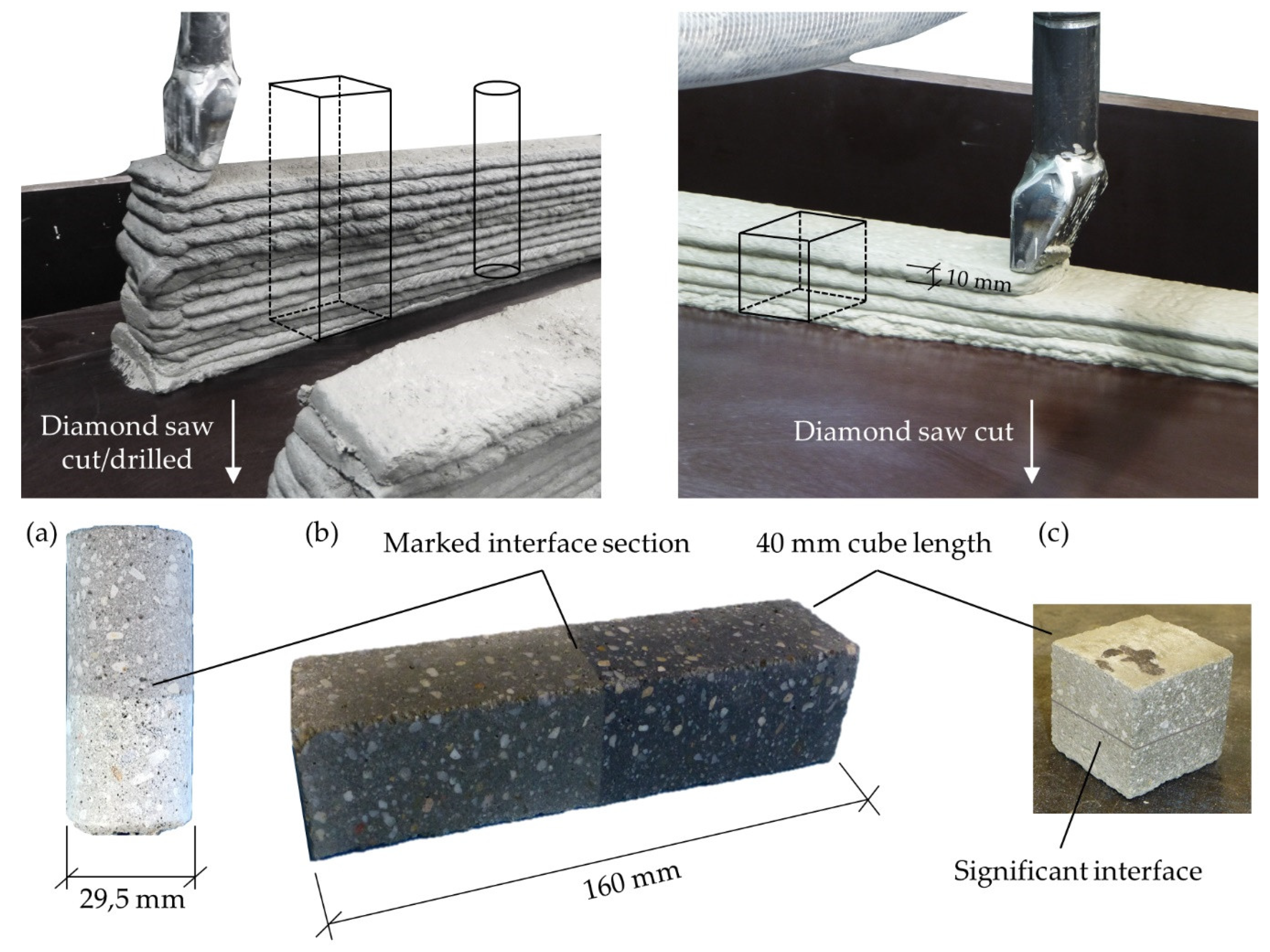
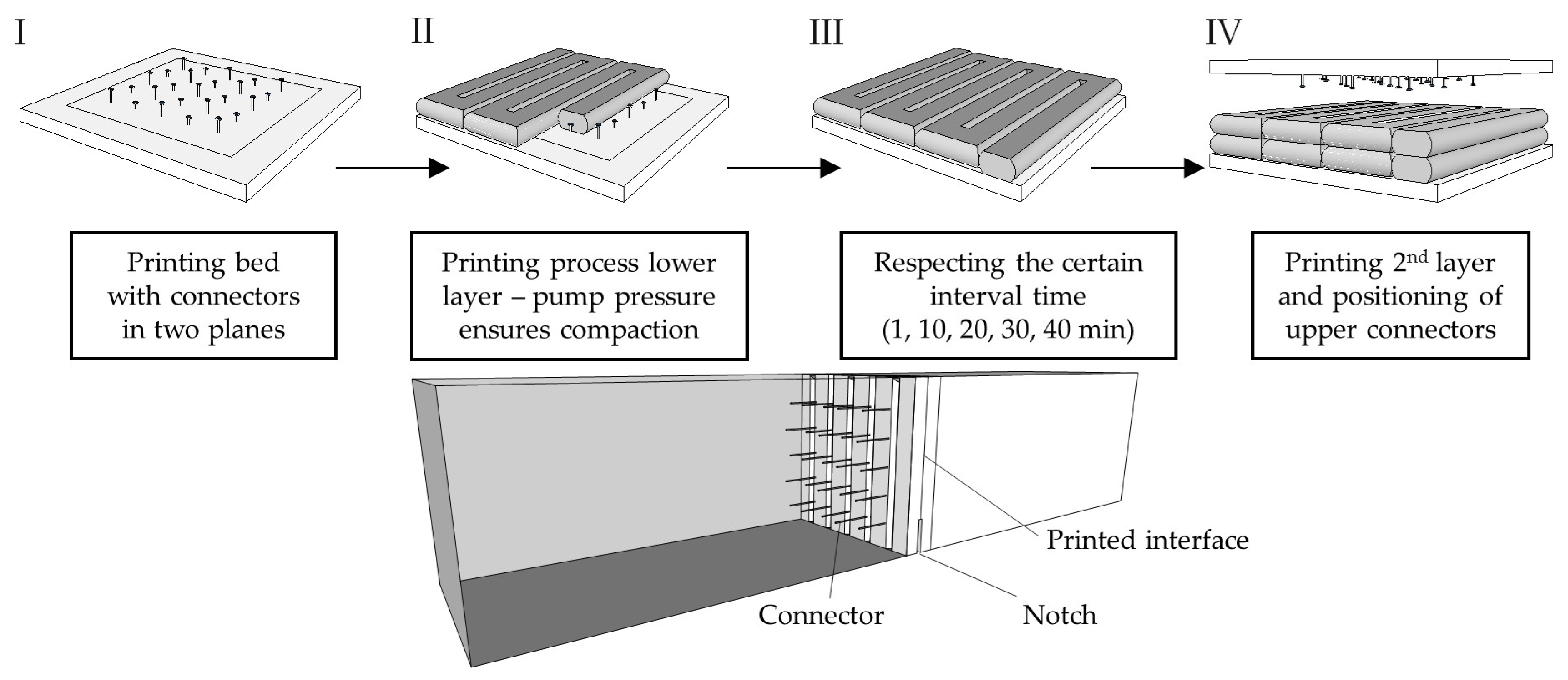
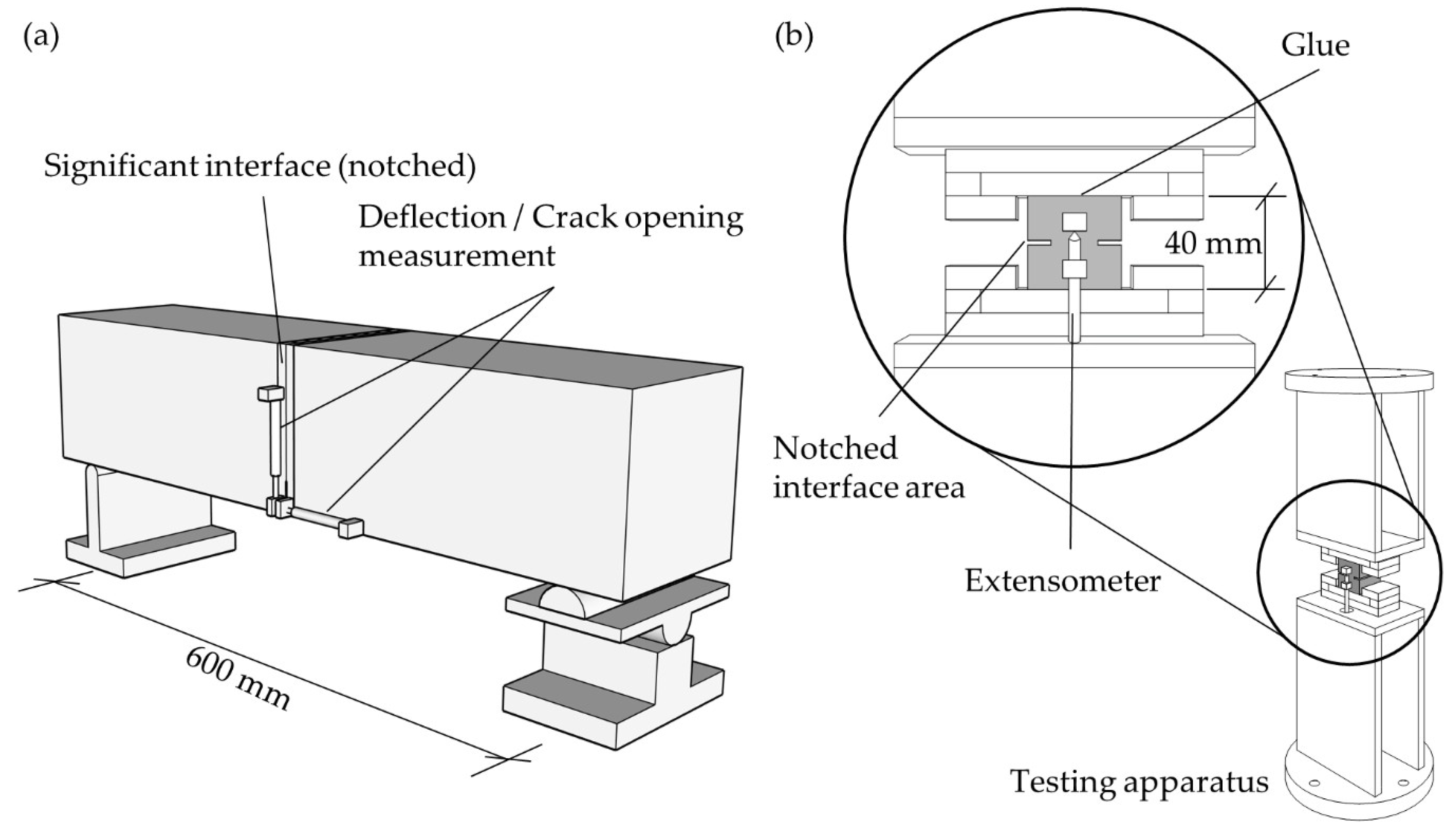



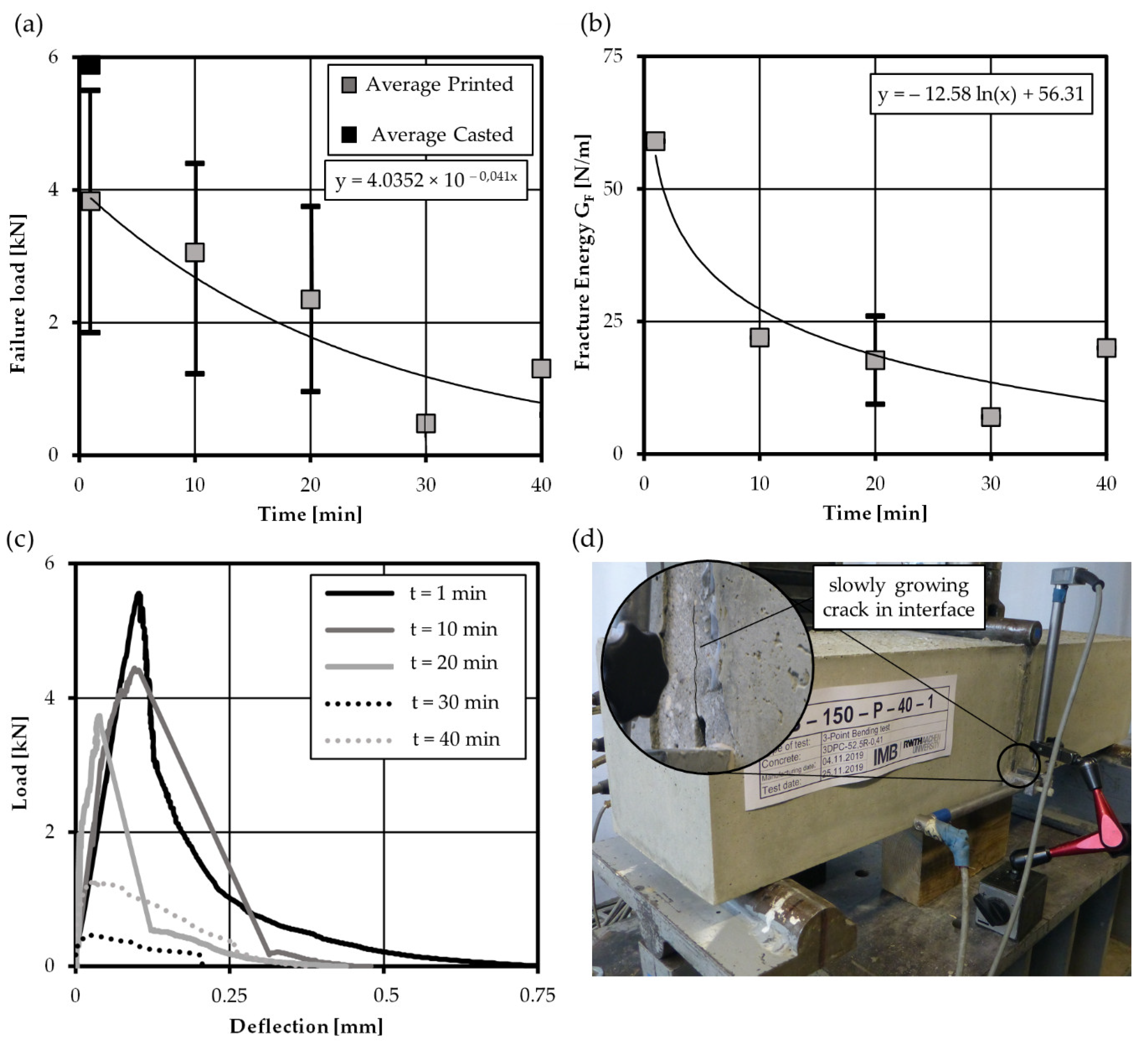
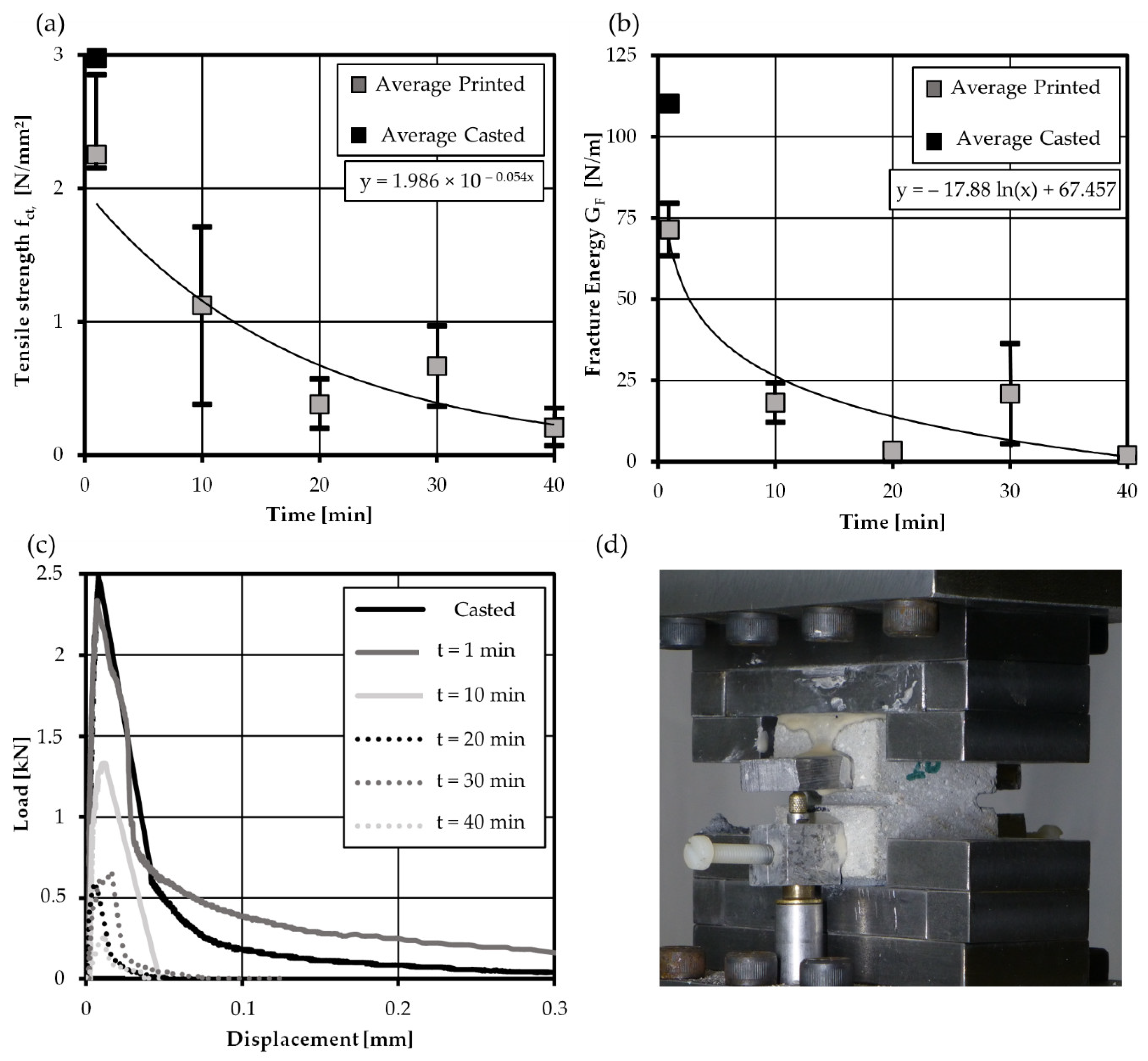




| Component | “Heidelberg” CEM I 52,5 R 1 | “Powerment” Fly Ash | Water | Aggregate | |
|---|---|---|---|---|---|
| Amount (kg/m³) | 550 | 250 | 280 | 1172 | |
| Sieve Fraction (mm) | Ratio Aggregate (%) | ||||
| 0.0–0.2 | 25 | ||||
| 0.2–1.0 | 30 | ||||
| 1.0–2.0 | 25 | ||||
| 2.0–4.0 | 20 | ||||
| Testing Method | Investigated Parameters | Specimen Dimensions | Notch |
|---|---|---|---|
| Three-point bending (Unnotched) | Flexural strength/ Anisotropy | 40 × 40 × 140 mm³ | - |
| Three-point bending (Notched) | Fracture Energy mode I | 150 × 150 × 700 mm³ | 30 mm |
| Uniaxial tensile test | Tensile strength / Fracture energy mode I | 40 × 40 × 40 mm³ | 7 mm |
| Compressive test | Compressive strength/ Anisotropy | 40 × 40 × 40 mm³ | - |
| Shear test | Shear strength | Drill core Ø 29.5 mm | - |
Publisher’s Note: MDPI stays neutral with regard to jurisdictional claims in published maps and institutional affiliations. |
© 2021 by the authors. Licensee MDPI, Basel, Switzerland. This article is an open access article distributed under the terms and conditions of the Creative Commons Attribution (CC BY) license (http://creativecommons.org/licenses/by/4.0/).
Share and Cite
Meurer, M.; Classen, M. Mechanical Properties of Hardened 3D Printed Concretes and Mortars—Development of a Consistent Experimental Characterization Strategy. Materials 2021, 14, 752. https://doi.org/10.3390/ma14040752
Meurer M, Classen M. Mechanical Properties of Hardened 3D Printed Concretes and Mortars—Development of a Consistent Experimental Characterization Strategy. Materials. 2021; 14(4):752. https://doi.org/10.3390/ma14040752
Chicago/Turabian StyleMeurer, Maximilian, and Martin Classen. 2021. "Mechanical Properties of Hardened 3D Printed Concretes and Mortars—Development of a Consistent Experimental Characterization Strategy" Materials 14, no. 4: 752. https://doi.org/10.3390/ma14040752
APA StyleMeurer, M., & Classen, M. (2021). Mechanical Properties of Hardened 3D Printed Concretes and Mortars—Development of a Consistent Experimental Characterization Strategy. Materials, 14(4), 752. https://doi.org/10.3390/ma14040752







